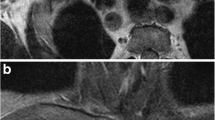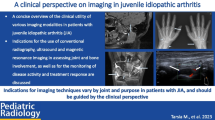Abstract
Objective
The sternoclavicular joint (SCJ), an important link between the appendicular and axial skeleton, though involved in 41% of rheumatoid arthritis patients, has not been studied in juvenile idiopathic arthritis (JIA). Hence, this cross-sectional study was done to delineate the magnetic resonance imaging (MRI) findings in SCJ in JIA and compare with the clinical examination to diagnose SCJ arthritis.
Methods
Of the 116 JIA patients attending the pediatric rheumatology clinic, twenty-one patients (42 SC joints) were evaluated by 1.5 T MRI using the four components of early and late inflammatory changes—synovial hypertrophy, bone marrow edema (BME), cartilage lesions, and bone erosions. Results were compared with clinical assessment of SCJ arthritis.
Results
Of the 42 SCJ evaluated (21/116 patients), MRI changes were seen in 27 SCJs (15 patients, 12.9% of 116 JIA patients). Early MRI changes were seen in 60% of joints found normal on clinical examination, with as much as 1/4th of them revealing late destructive changes. Synovial hypertrophy, BME, cartilage lesions, and bone erosions were seen in 5, 15, 4, and 10 patients, respectively. Sensitivity and specificity of clinical examinations to evaluate SC joint involvement were 55.5% and 53.3%, respectively.
Conclusion
MRI evaluation of the SCJ in JIA revealed findings in 15/21 enrolled patients. BME, bone erosions, synovial hypertrophy, and cartilage lesions were seen in 15, 10, 5, and 4 enrolled patients, respectively. Clinical examination was found to be neither sensitive nor specific.
Key Points • MRI could delineate both early and late inflammatory changes in SCJ in JIA. BME, bone erosions, synovial hypertrophy, and cartilage lesions were seen in 15, 10, 5, and 4 enrolled patients, respectively. • The frequency of SC joint involvement in JIA was at least 12.9% of patients in our study. • Clinical examination for evaluating SC joint arthritis has low sensitivity (55.5%) and specificity (53.3%). |





Similar content being viewed by others
Data availability
Data analyzed during the study are included in this article. Original data is available with the corresponding author and shall be made available on reasonable request.
References
Petty RE, Laxer RM, Wedderburn LR (2016) Juvenile idiopathic arthritis, Chapter 15. In: Petty RE, Laxer RM, Lindsley CB, Wedderburn LR (eds) Textbook of Pediatric Rheumatology, vol 2016, 7th edn. Elsevier Saunders, p 195
Hemke R, Maas M, van Veenendaal M, Dolman KM, van Rossum MAJ, van den Berg JM, Kuijpers TW (2014) Contrast-enhanced MRI compared with the physical examination in the evaluation of disease activity in juvenile idiopathic arthritis. Eur Radiol 24:327–334
Miller E, Uleryk E, Doria AS (2009) Evidence-based outcomes of studies addressing diagnostic accuracy of MRI of juvenile idiopathic arthritis. Am J Roentgenol 192(5):1209–1218. https://doi.org/10.2214/AJR.08.2304
Nistala K, Babar J, Johnson K, Campbell-Stokes P, Foster K, Ryder C et al (2007) Clinical assessment an core outcome variables are poor predictors of hip arthritis diagnosed by MRI in juvenile idiopathic arthritis. Rheumatology (Oxford) 46:699–702
Rodríguez-Henríquez P, Solano C, Peña A, León-Hernández S, Hernández-Díaz C, Gutiérrez M, Pineda C (2013) Sternoclavicular joint involvement in rheumatoid arthritis: clinical and ultrasound findings of a neglected joint. Arthritis Care Res 65:1177–1182
Vilca I, Munitis PG, Pistorio A, Ravelli A, Buoncompagni A, Bica B, Campos L, Hafner R, Hofer M, Ozen S, Huemer C, Bae SC, Sztajnbok F, Arguedas O, Foeldvari I, Huppertz HI, Gamir ML, Magnusson B, Dressler F, Uziel Y, van Rossum MAJ, Hollingworth P, Cawkwell G, Martini A, Ruperto N, for the Pediatric Rheumatology International Trials Organisation (PRINTO) (2010) Predictors of poor response to methotrexate in polyarticular-course juvenile idiopathic arthritis: analysis of the PRINTO methotrexate trial. Ann Rheum Dis 69:1479–1483
Albers HM, Wessels JAM, van der Straaten RJHM, Brinkman DMC, Suijlekom-Smit LWA, Kamphuis SSM et al (2009) Time to treatment as an important factor for the response to methotrexate in juvenile idiopathic arthritis. Arthritis Rheum 61:46–51
Hemke R, van Rossum MAJ, van Veenendaal M, Terra MP, Deurloo EE, de Jonge MC, van den Berg JM, Dolman KM, Kuijpers TW, Maas M (2013) Reliability and responsiveness of the juvenile arthritis MRI scoring (JAMRIS) system for the knee. Eur Radiol 23:1075–1083
Gylys-Morin VM, Graham TB, Blebea JS, Dardzinski BJ, Laor T, Johnson ND, Oestreich AE, Passo MH (2001) Knee in early juvenile rheumatoid: MR imaging findings. Radiology. 220:696–706
Tuscono D, Baneerjee S, Terk M (2000) Variations in normal sterno-clavicular joints; a retrospective study to quantify SCJ asymmetry. Skeletal Radio 38:997–1001
Tonge AV, De Wilde L (2012) Ternoclavicular joint injuries: a literature review. Muscles Ligaments Tendons J 1(3):100–105
Ramgopal S, Rosenkranz M, Nowalk AJ, Zuckerbraun NS (2018) Sternoclavicular arthritis as a clinical presentation for lyme disease. Pediatrics 141(Suppl 5):S466–S469. https://doi.org/10.1542/peds.2017-0725
Alves S, Rodrigues L, Santos M, Moreira D (2018) Kingella kingae sternoclavicular osteoarthritis. BMJ Case Rep 2018:bcr2017223213. https://doi.org/10.1136/bcr-2017-223213
Paez-Perez Y, McGovern T, Flannery A, Naim F (2017) Sternoclavicular septic arthritis caused by Streptococcus pyogenes in a child. Clin Pract Cases Emerg Med 1(4):312–314. https://doi.org/10.5811/cpcem.2017.5.33811.eCollection2017Nov
Frikha F, Marzouk S, Kaddour N, Frigui M, Bahloul Z (2009) Destructive arthritis in Behçet’s disease: a report of eight cases and literature review. Int J Rheum Dis 12(3):250–255. https://doi.org/10.1111/j.1756-185X.2009.01419.x
Cheng J (2014) A rare cause of pediatric dysphagia: posterior dislocation of the sternoclavicular joint. Int J PediatrOtorhinolaryngol 78(1):152–153. https://doi.org/10.1016/j.ijporl.2013.09.027
Vrdoljak J, Irha E (2000) Synovial osteochondromatosis of the sternoclavicular joint. PediatrRadiol 30(3):181–183. https://doi.org/10.1007/s002470050041
Robinson CM, Jenkins PJ, Markham PE, Beggs I (2008) Disorders of the sternoclavicular joint. J Bone Joint Surg (Br) 90:685–696
Huang P, Chang L, Guo MM, Kuo H (2019) Successful treatment in a child with enthesitis-related arthritis involving the sternoclavicular joint: a case report. BMC Pediatr 19(1):373. https://doi.org/10.1186/s12887-019-1770-6
Cassidy JT, Levinson JE, Bass JC, Baum J, Brewer EJ, Fink CW, Hanson V, Jacobs JC, Masi AT, Schaller JG, Fries JF, McShane D, Young D (1986) A study of classification criteria for a diagnosis of juvenile rheumatoid arthritis. Arthritis Rheum 29:274–281
Østergaard M, Peterfy C, Conaghan P, McQueen F, Bird P, Ejbjerg B, Shnier R, O'Connor P, Klarlund M, Emery P, Genant H, Lassere M, Edmonds J (2003) OMERACT rheumatoid arthritis magnetic resonance imaging studies. Core set of MRI acquisitions, joint pathology definitions, and the OMERACT RA-MRI scoring system. J Rheumatol 30:1385–1386
Celikyay F, Yuksekkaya R, Inanir A, Deniz C (2013) Multidetector computed tomography findings of the sternoclavicular joint in patients with rheumatoid arthritis. Clin Imaging 37:1104–1108
Abel MS (1979) Symmetrical anteroposterior projections of the sternoclavicular joints with motion studies. Radiology 132:757–759. https://doi.org/10.1148/132.3.757
Shin MS, Berland LL, Ho KJ (1986) Computed tomography evaluation of primary and secondary sternal neoplasms. J ComputTomogr 10:27–32. https://doi.org/10.1016/0149-936x(86)90005-6
Lee FA, Gwinn JL (1974) Retrosternal dislocation of clavicle. Radiology. 110:631–634. https://doi.org/10.1148/110.3.631
Verbruggen LA, Shahabpour M, Van Roy P, OsteauxM (1990) Magnetic resonance imaging of articular destruction in juvenile rheumatoid arthritis. Arthritis Rheum 33:1426–1430
Malattia C, Damasio MB, Magnaguagno F, Pistorio A, Valle M, Martinoli C, Viola S, Buoncompagni A, Loy A, Ravelli A, Tomà P, Martini A (2008) Magnetic resonance imaging, ultrasonography, and conventional radiography in the assessment of bone erosions in juvenile idiopathic arthritis. Arthritis Rheum 59:1764–1772
Nandi M, Ganguli SK, Mondal R, Ghosh A (2009) Clinico-serological profile of juvenile idiopathic arthritis. Indian Pediatr 46:640–641
Singh S, Salaria M, Kumar L, Minz R, Datta U, Sehgal S (1999) Clinico-immunological profile of juvenile rheumatoid arthritis at Chandigarh. Indian Pediatr 36:449–454
Sircar D, Ghosh B, Ghosh A, Haldar S (2006) Juvenile idiopathic arthritis. Indian Pediatr 43:429–433
Müller LS, Avenarius D, Damasio B, Eldevik OP, Malattia C, Lambot-Juhan K et al (2011) The paediatric wrist revisited: redefining MR findings in healthy children. Ann Rheum Dis 70:605–610. https://doi.org/10.1136/ard.2010.135244
Jans LB, Jaremko JL, Ditchfield M, Verstraete KL (2011) (2011) Evolution of femoral condylar ossification at MR imaging: frequency and patient age distribution. Radiology. 258:880–888. https://doi.org/10.1148/radiol.10101103
Zawin JK, Jaramillo D (1998) Conversion of bone marrow in the humerous, sternum, and clavicle : changes with age on MR images. Radiology 188:149–164
Malattia C, Damasio MB, Bassio C, Santoro M, Verri A, Pederzoli S et al (2012) Novel automated system for magnetic resonance imaging quantification of the inflamed synovial membrane volume in patients with juvenile idiopathic arthritis. Arthritis Care Res 64:1657–1664. https://doi.org/10.1002/acr-21739
Nusman CM, Hemke R, Schonenberg D, Dolman KM, van Rossum MA, Kuijpers TW et al (2014) Distribution pattern of MRI abnormalities within the knee and wrist of juvenile idiopathic arthritis patients: signature of disease activity. AJR 202:W439–W446. https://doi.org/10.2214/AJR.13.11314
Bennet JL, Wood A, Smith N, Mistry R, Allen K, Jandial S et al (2019) Can quantitative MRI be used in the clinical setting to quantify the impact of intra-articular glucocorticoid injection on synovial disease activity in juvenile idiopathic arthritis ? Pediatr Rheumatol 17:74. https://doi.org/10.1186/s12969-019-0377-7
Acknowledgment
We acknowledge Mrs. Parul Chug, statistician for all the statistical work.
Author information
Authors and Affiliations
Contributions
T.P.Yadav: Conceptualized the study and study design, data analysis, editing the manuscript and giving final shape, guarantor of the paper
Prasad Brijendra: Collected the data. Wrote draft manuscript
Murugan Sudhakar: Data analysis, manuscript writing, editing, intellectual inputs
Somdipa Pal: Data analysis, manuscript writing, editing, intellectual inputs
Jessica Laltlansangi Hlawndo: Revision of manuscript, data analysis, intellectual inputs
Namrita Sachdev: Data analysis, manuscript writing, editing, intellectual inputs
Corresponding author
Ethics declarations
Disclosures
None
Consent for publication
Not applicable, not used anybody else’s data
Ethical approval
The study was approved by the Institutional Ethics Committee and has been performed according to the ethical standards laid down 1964 Declaration of Helsinki and its amendments. All the study subjects’ caregivers gave the informed consent prior to the enrolment in the study, and assent was given by adolescents.
Additional information
Publisher’s note
Springer Nature remains neutral with regard to jurisdictional claims in published maps and institutional affiliations.
Rights and permissions
About this article
Cite this article
Brijendra, P., Sudhakar, M., Pal, S. et al. Magnetic resonance imaging findings in the sternoclavicular joint in juvenile idiopathic arthritis and comparison with clinical examination. Clin Rheumatol 40, 2351–2359 (2021). https://doi.org/10.1007/s10067-020-05525-2
Received:
Revised:
Accepted:
Published:
Issue Date:
DOI: https://doi.org/10.1007/s10067-020-05525-2




